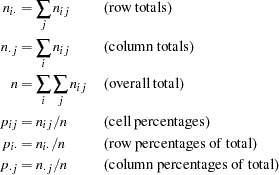| The FREQ Procedure |
Definitions and Notation
A two-way table represents the crosstabulation of row variable X and column variable Y. Let the table row values or levels be denoted by  ,
,  , and the column values by
, and the column values by  ,
,  . Let
. Let  denote the frequency of the table cell in the
denote the frequency of the table cell in the  th row and
th row and  th column and define the following notation:
th column and define the following notation:
 |
 |
 |
 |
Scores
PROC FREQ uses scores of the variable values to compute the Mantel-Haenszel chi-square, Pearson correlation, Cochran-Armitage test for trend, weighted kappa coefficient, and Cochran-Mantel-Haenszel statistics. The SCORES= option in the TABLES statement specifies the score type that PROC FREQ uses. The available score types are TABLE, RANK, RIDIT, and MODRIDIT scores. The default score type is TABLE. Using MODRIDIT, RANK, or RIDIT scores yields nonparametric analyses.
For numeric variables, table scores are the values of the row and column levels. If the row or column variable is formatted, then the table score is the internal numeric value corresponding to that level. If two or more numeric values are classified into the same formatted level, then the internal numeric value for that level is the smallest of these values. For character variables, table scores are defined as the row numbers and column numbers (that is, 1 for the first row, 2 for the second row, and so on).
Rank scores, which you request with the SCORES=RANK option, are defined as
 |
where  is the rank score of row
is the rank score of row  , and
, and  is the rank score of column
is the rank score of column  . Note that rank scores yield midranks for tied values.
. Note that rank scores yield midranks for tied values.
Ridit scores, which you request with the SCORES=RIDIT option, are defined as rank scores standardized by the sample size (Bross 1958, Mack and Skillings 1980). Ridit scores are derived from the rank scores as
 |
Modified ridit scores (SCORES=MODRIDIT) represent the expected values of the order statistics of the uniform distribution on (0,1) (van Elteren 1960, Lehmann 1975). Modified ridit scores are derived from rank scores as
 |
Copyright © 2009 by SAS Institute Inc., Cary, NC, USA. All rights reserved.